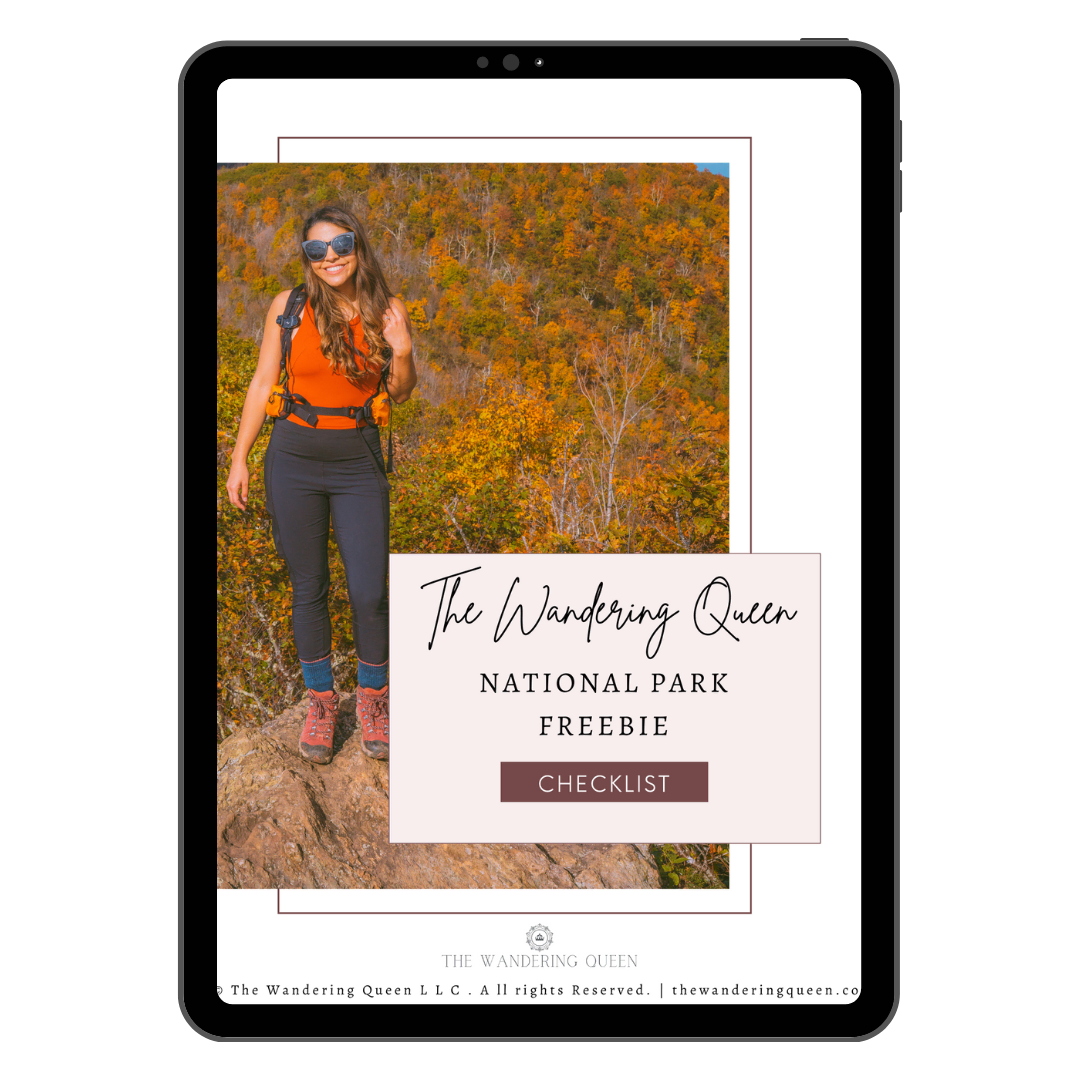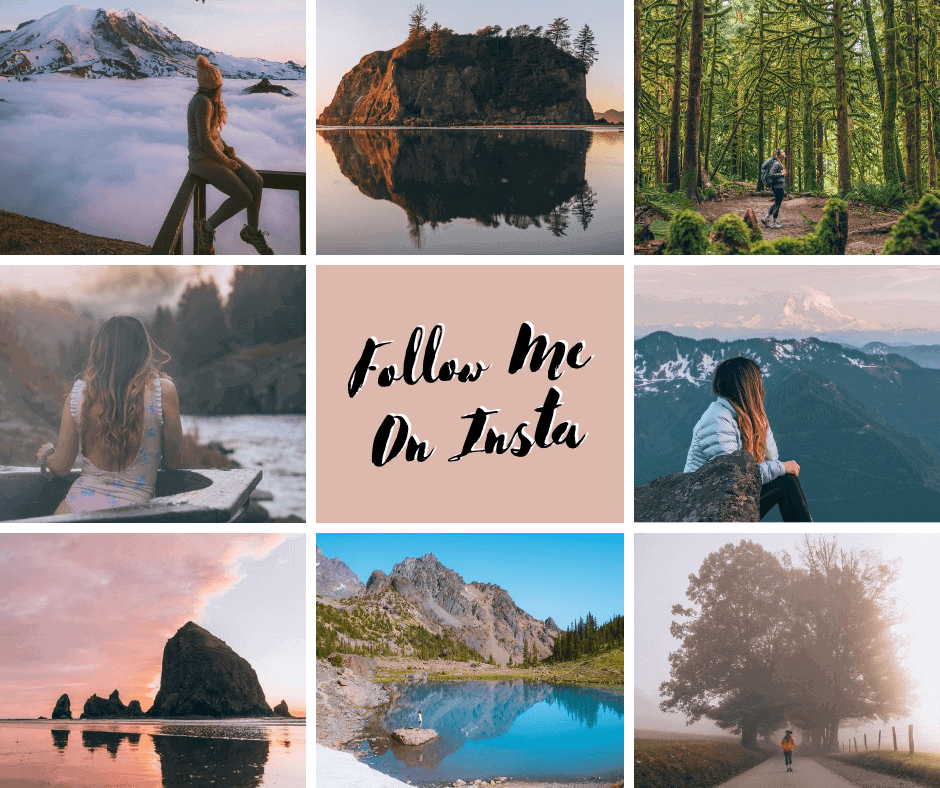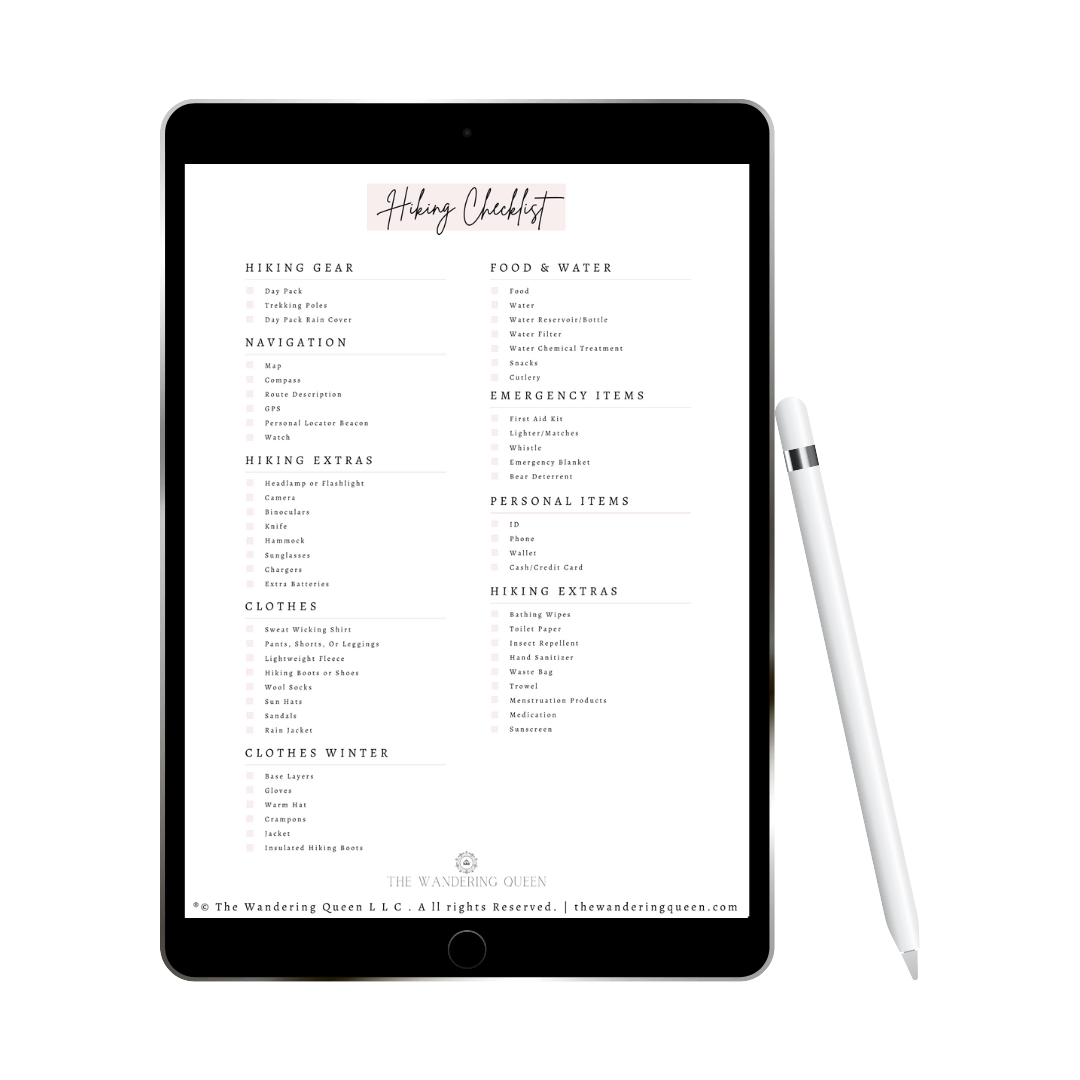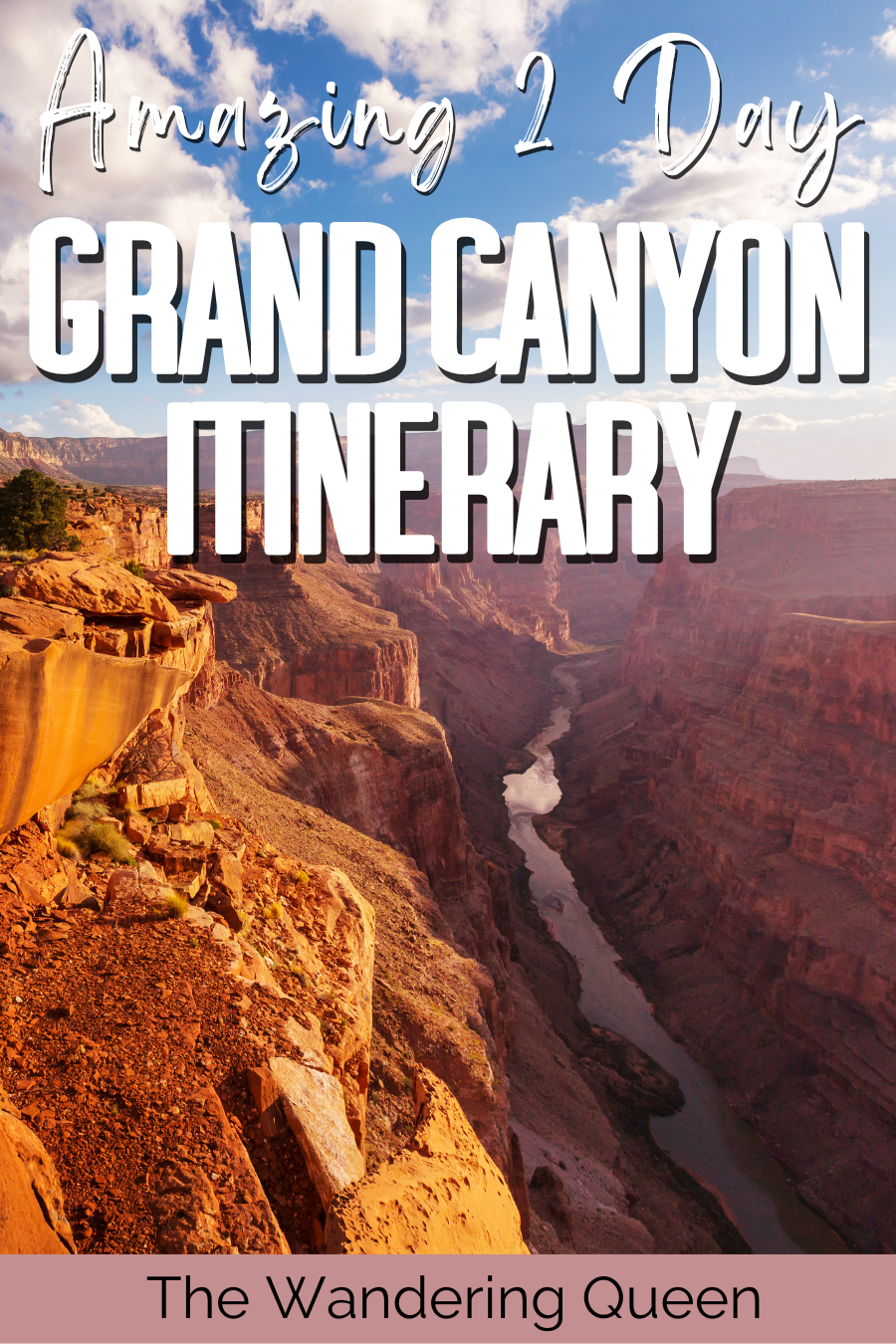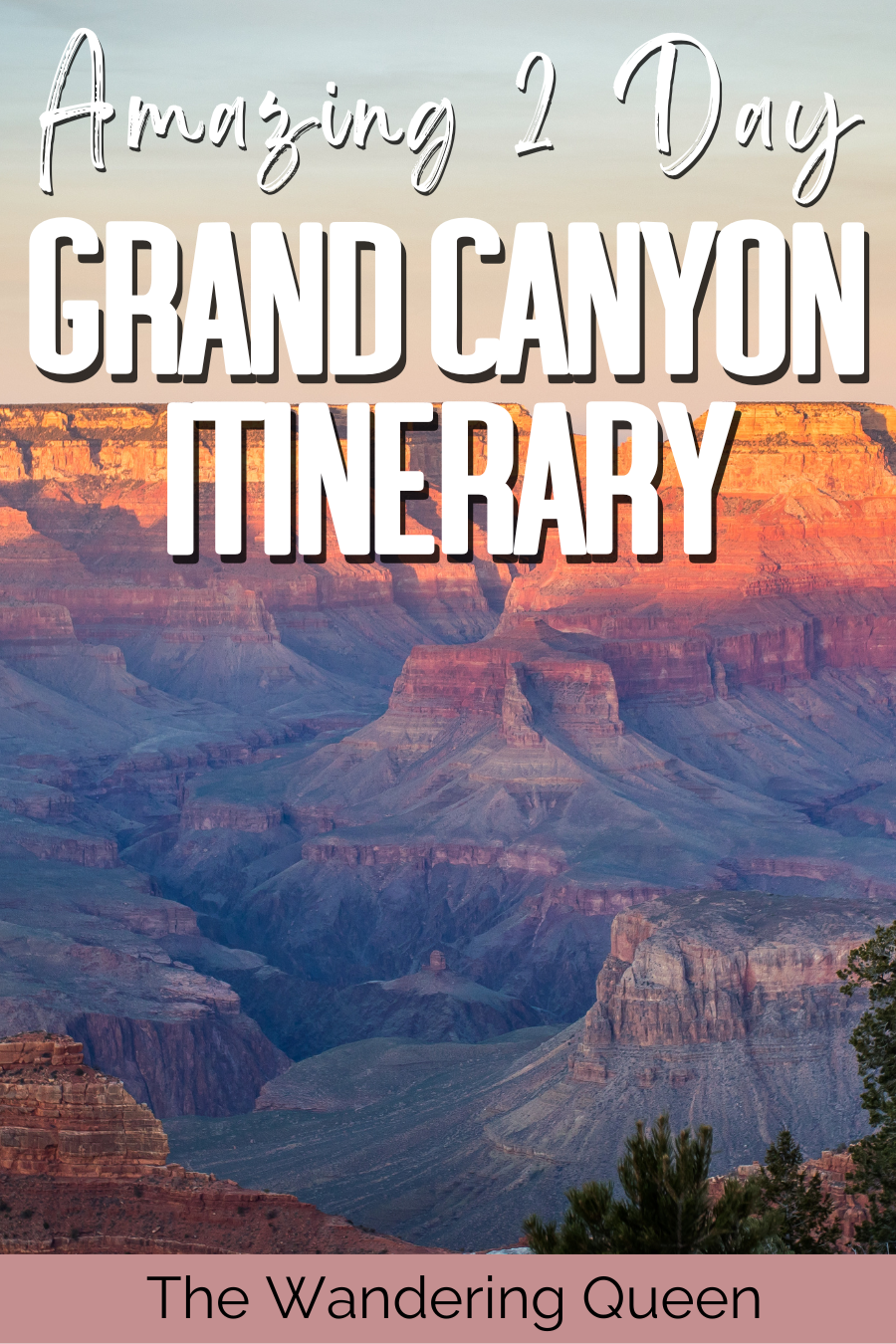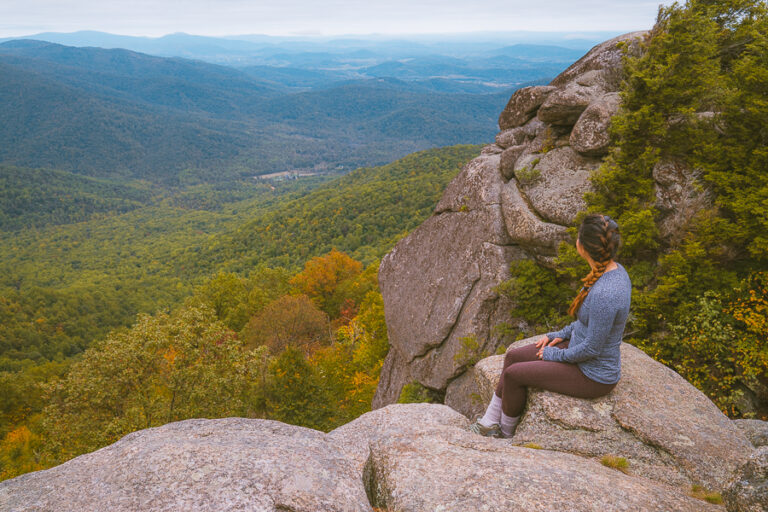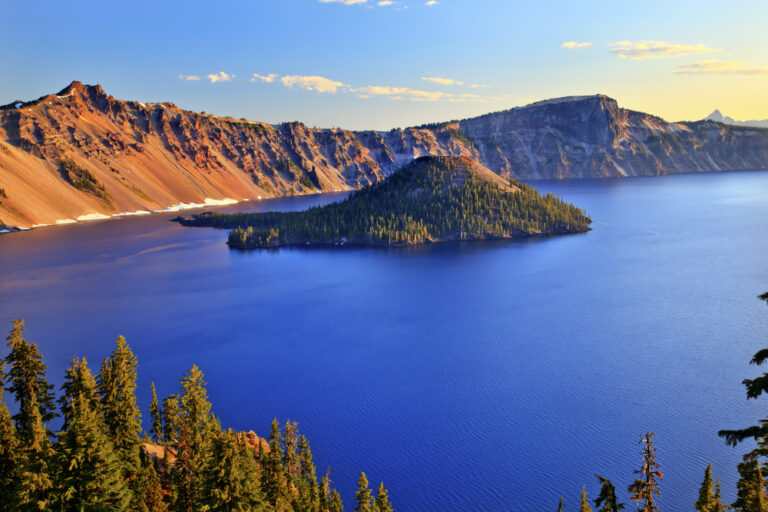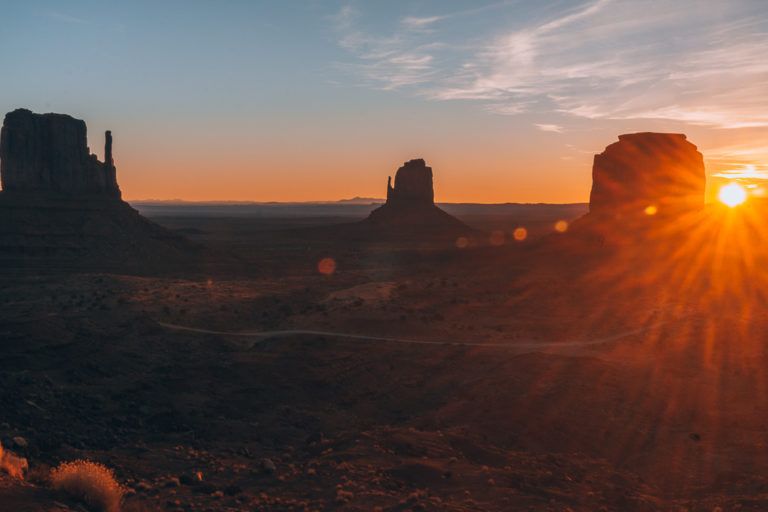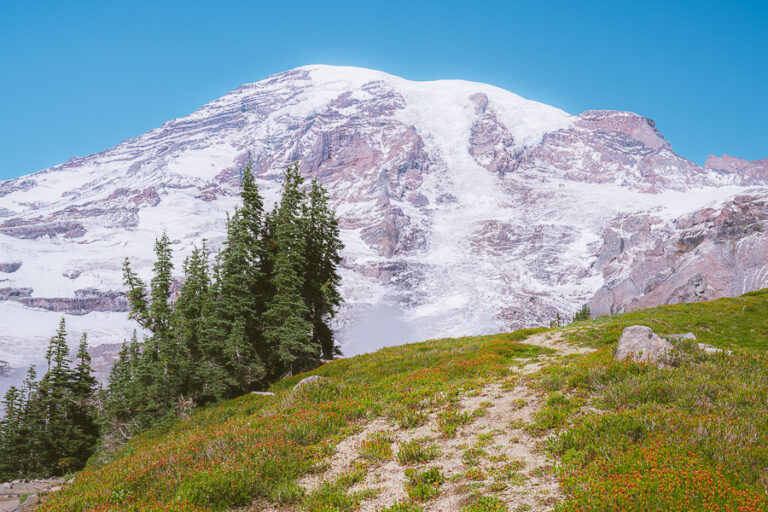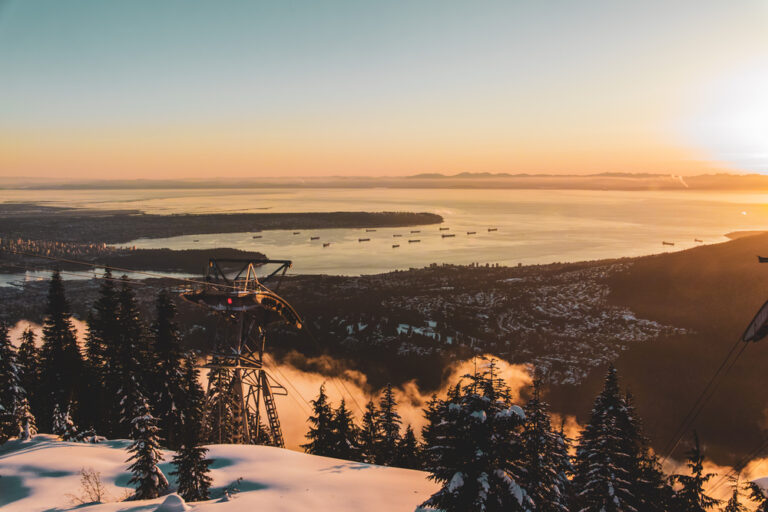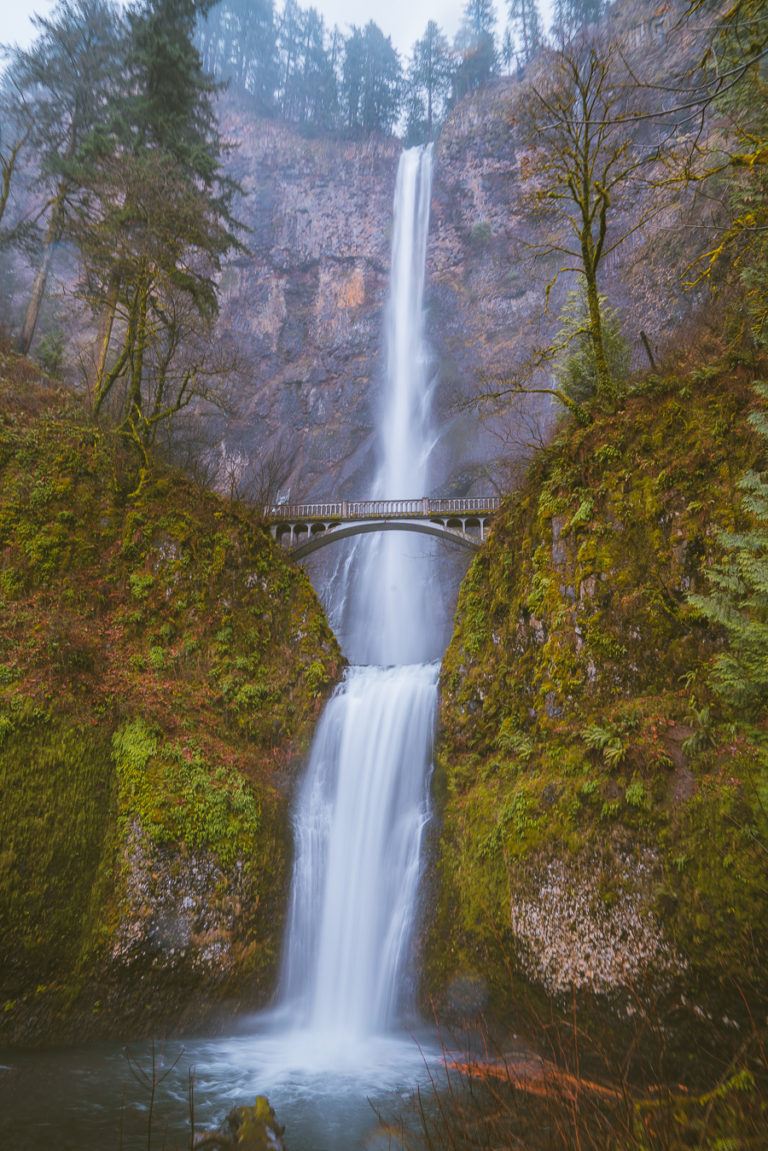2-Day Grand Canyon Itinerary | Things to Do + Insider Tips
The Grand Canyon needs no introduction, and regardless of which words you choose to describe it, they’ll never quite cut it. But that’s what makes it such an amazing place to visit and an even better place to spend a night (or two).
Covering more than 2,000 square miles, the Grand Canyon is well deserving of its name. Within the borders of its North and South Rim, more than 6 million annual visitors find a slice of personal outdoor heaven.
Thankfully, there’s more than enough natural beauty to go around. In fact, it may be daunting to figure out what to see and do, especially if you’re pressed for time. Well, you’re in luck. You’re in the right place for a great time with the icon and this curated 2-day Grand Canyon itinerary.
Jam-packed with everything you need to know, read on to discover how to make the most of your 2-day adventure to one of the world’s seven natural wonders.
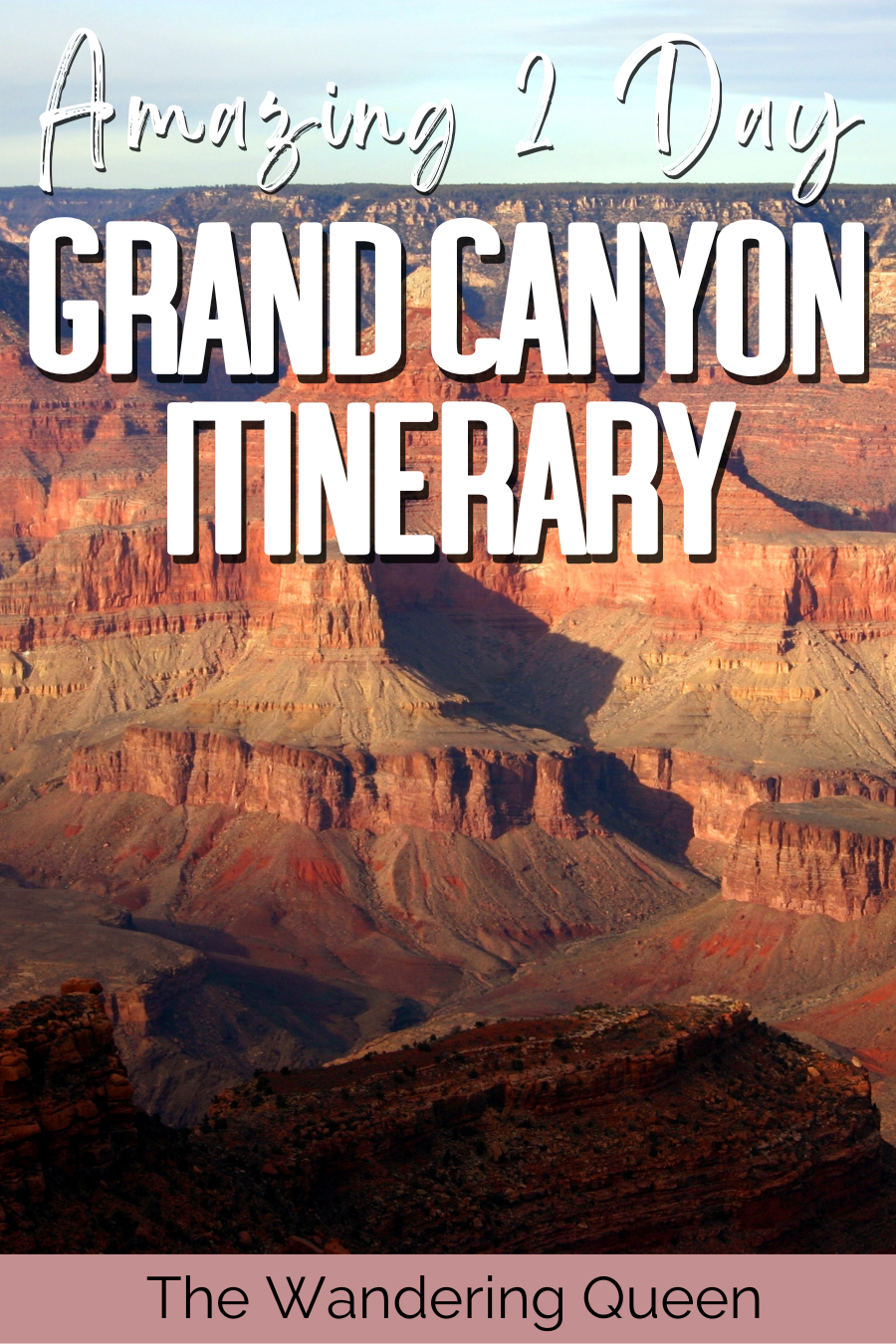
Disclosure: This post contains affiliate links. If you click one of them, I may receive a small commission (for which I am very grateful for) at no extra cost to you.
Grand Canyon National park
Related Posts
Grand Canyon National Park Itinerary Map
You can easily copy and print the itinerary below, but I’ve included this handy map with the highlights of each day marked down to make things a little easier.
The Only 2-Day Grand Canyon National Park Itinerary You’ll Ever Need
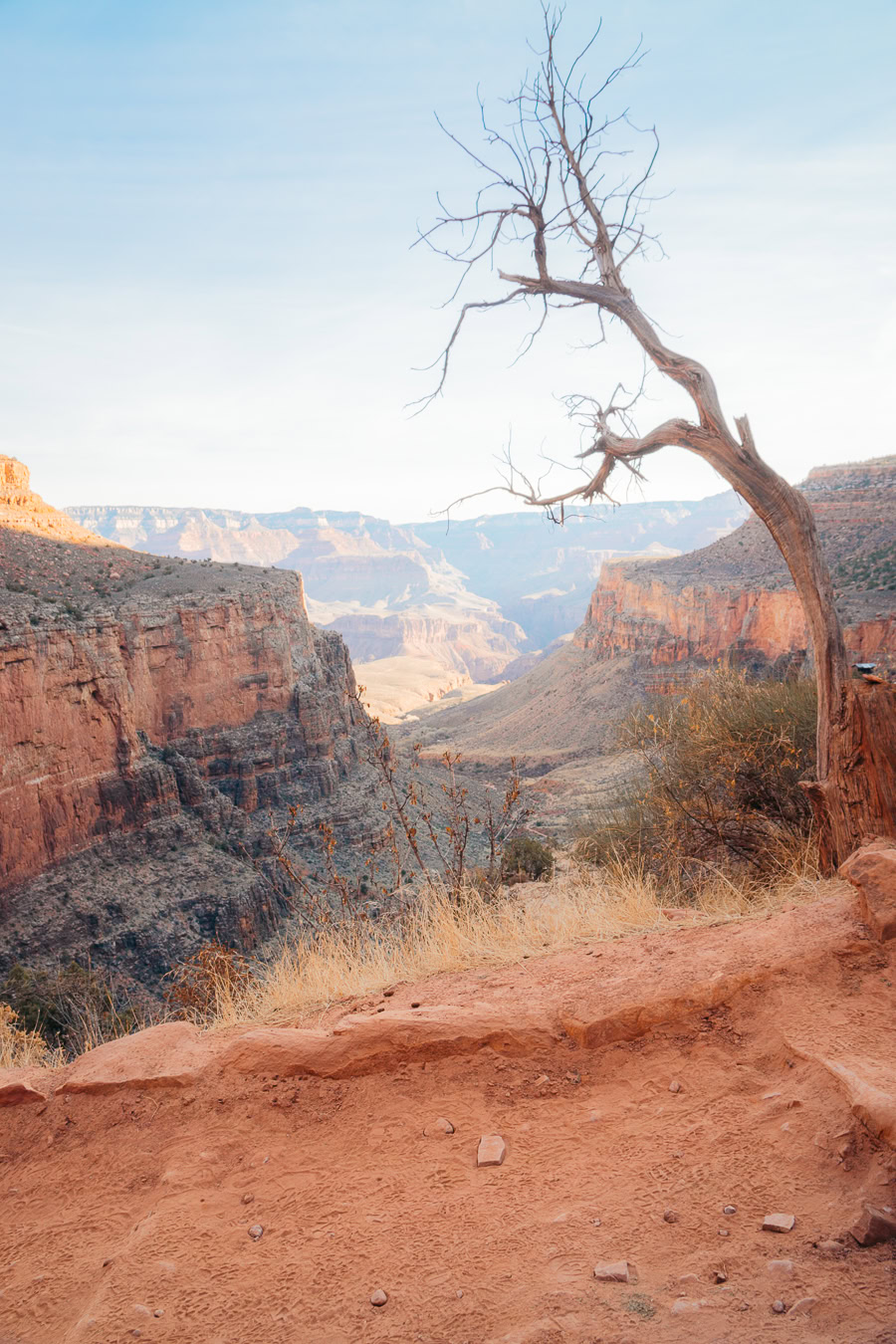
Any trip to the Grand Canyon guarantees a memorable adventure, but with visiting the Grand Canyon in two days, there’s lots to fit in. Whether you’re hunting for the best Grand Canyon hiking trails or searching for the most breathtaking viewpoints, you’re in for an incredible time.
Day One in Grand Canyon National Park
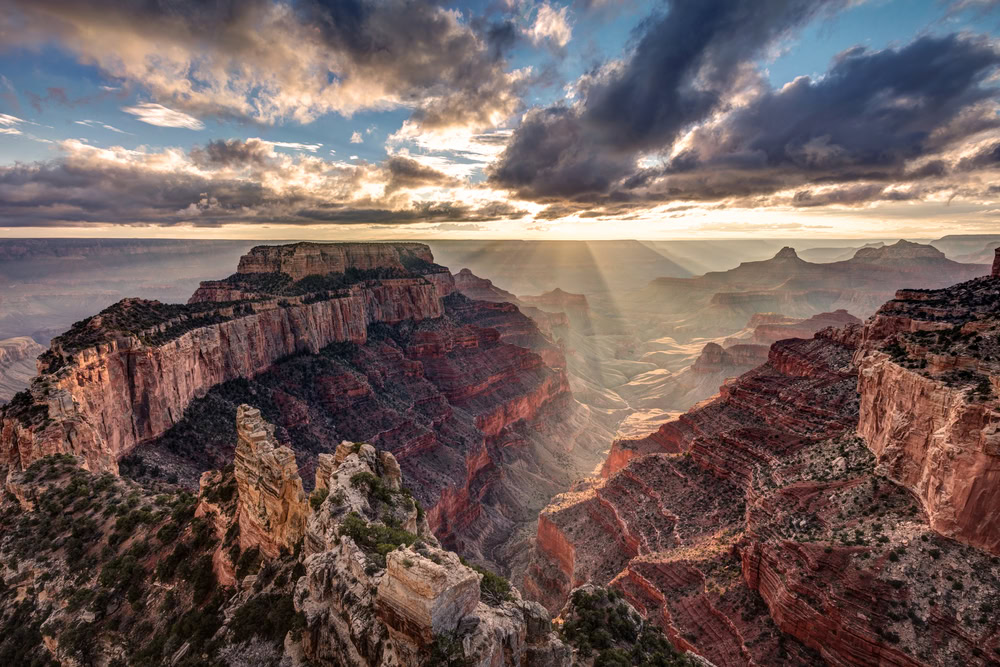
Your first day in the Grand Canyon delivers some of what makes this one of the country’s most loved national parks. From the bustling Grand Canyon Village to the captivating views from famous lookout points like Mather Point, let’s get going.
Start the Morning at the Grand Canyon Visitor Center
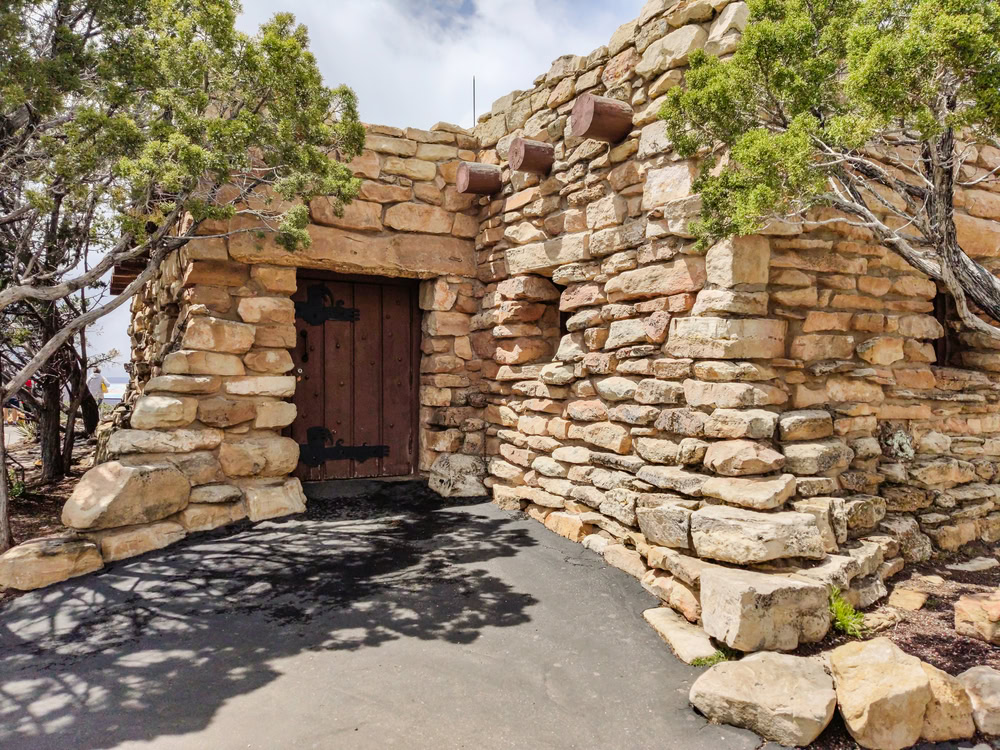
To start your Grand Canyon two-day itinerary, the first stop is the Grand Canyon Visitor Center. Located near the south entrance to the park, it’s the perfect introduction to the canyon and offers many chances to learn about the park.
It’s best to get here as early as possible, as it does get crazy busy, and parking lots typically fill up by 10 am, especially during the summer, over spring break, and fall weekends.
Aside from being the ideal place to grab a few maps, the visitor center also features a café, a bike rental counter, indoor exhibits, and an IMAX theater. The center is also a central transit hub for the park, and the shuttle bus service runs through here to numerous hiking trails and viewpoints.
Take your time here to talk to the friendly National Park Service rangers who can quickly answer any questions and get you on your way. Beyond that, don’t skip the opportunity to see the 20-minute orientation movie Grand Canyon: A Journey of Wonder.
Near the visitor center, heading towards the Grand Canyon Village, is another fantastic place to learn more about the formation of the canyon, the Yavapai Geology Museum. This is also where you can head on The Trail of Time and Yavapai Point.
Check out Mather Point
- Mileage: 0.6 miles out-and-back
- Elevation Gain: 13 feet
- Difficulty: Easy
- Trail Guide: Link
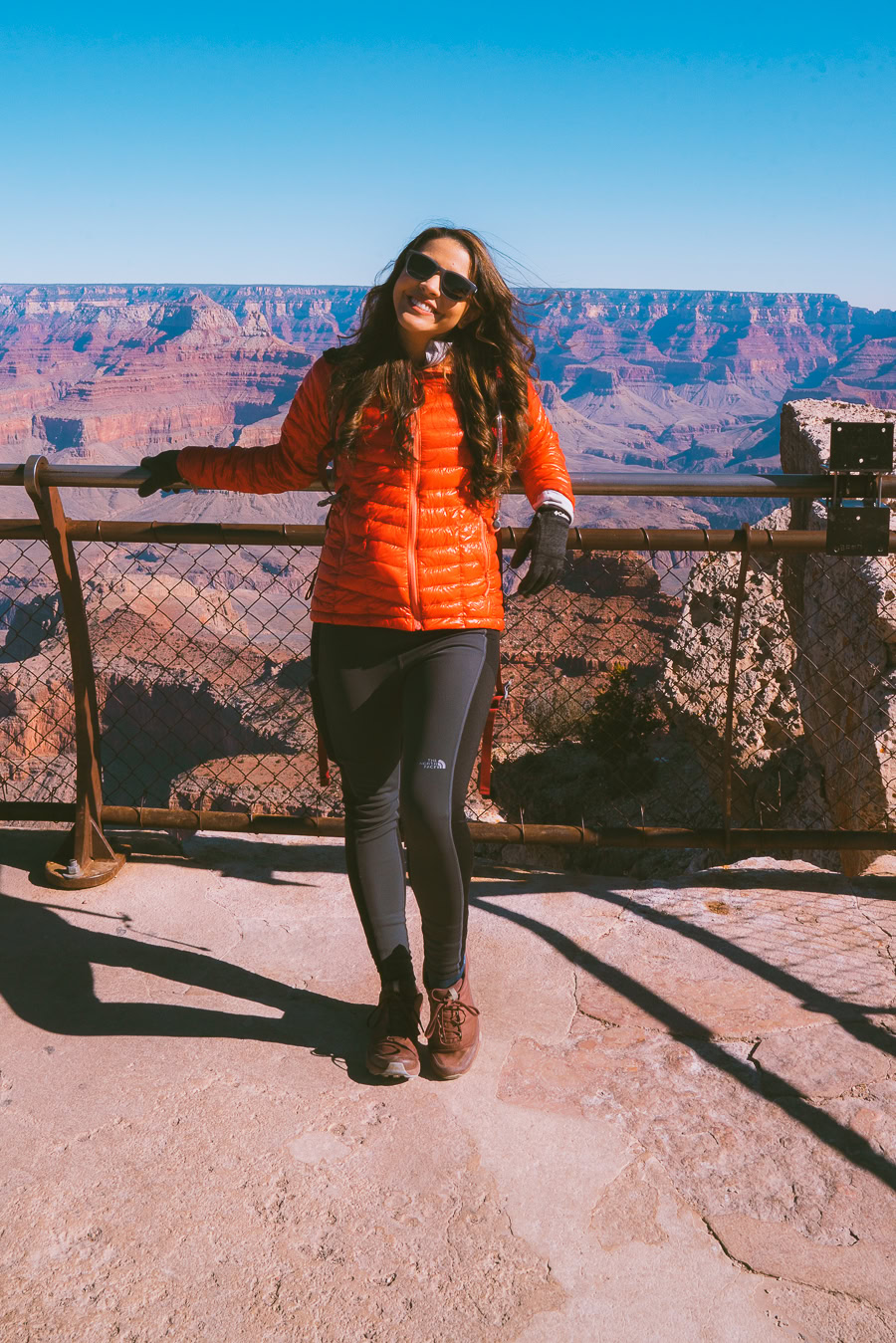
After your stop at the visitor center, you’ll head to one of the Grand Canyon’s South Rim standouts – Mather Point.
Named after the first director of the National Park Service, Stephen Mather, the captivating views from this vantage point are world-famous and a sight you won’t forget. Adding to its popularity, reaching the viewpoint is extremely easy, and the out-and-back walk should take about 10 to 15 minutes.
Reaching the lookout point, the scale of the canyon does come to life as you marvel out across a 10-mile stretch towards the North Rim. Take the opportunity to admire the mile-deep abyss below, the snaking Colorado River, and the vibrant Kaibab Limestone.
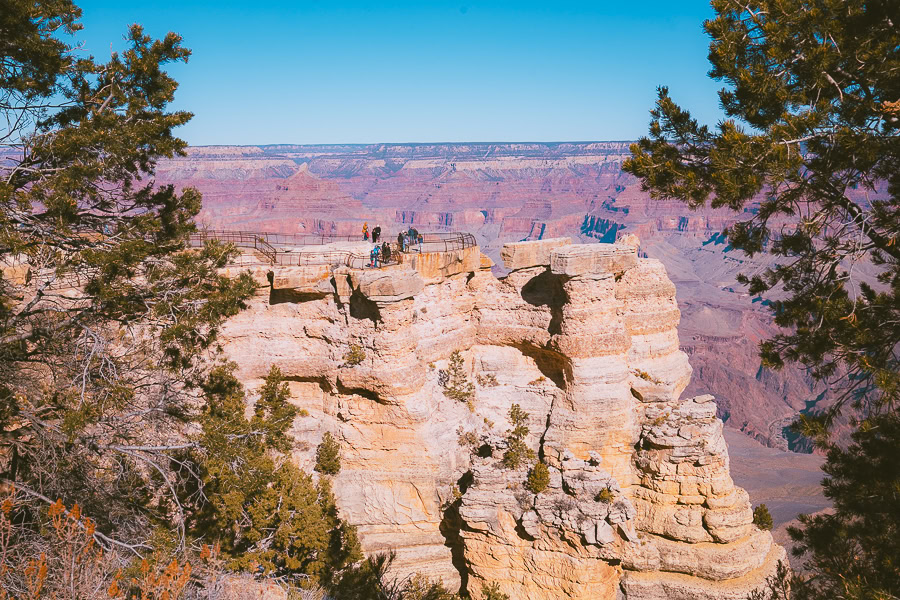
Mather Point features two overlooks built on a rock that juts pretty far into the canyon, giving you some unbeatable scenes. Spanning from the Bright Angel Trail in the west to the South Kaibab Trail in the east, highlights to spot are Pipe Creek, O’Neill Butte, the Tonto Trail, and Bright Angel Creek.
Thanks to the short walking distance, paved walkways, and various upgrades like a rim-side amphitheater, additional shuttle bus stops, and picnic areas, Mather Point sees a lot of visitors. This does make it quite easily crowded, especially at sunrise and sunset.
Download my free Outdoor Photography Guide
Walk Some of the Rim Trail
- Mileage: 12.7 miles point-to-point
- Elevation Gain: 583 feet
- Difficulty: Moderate
- Trail Guide: Link
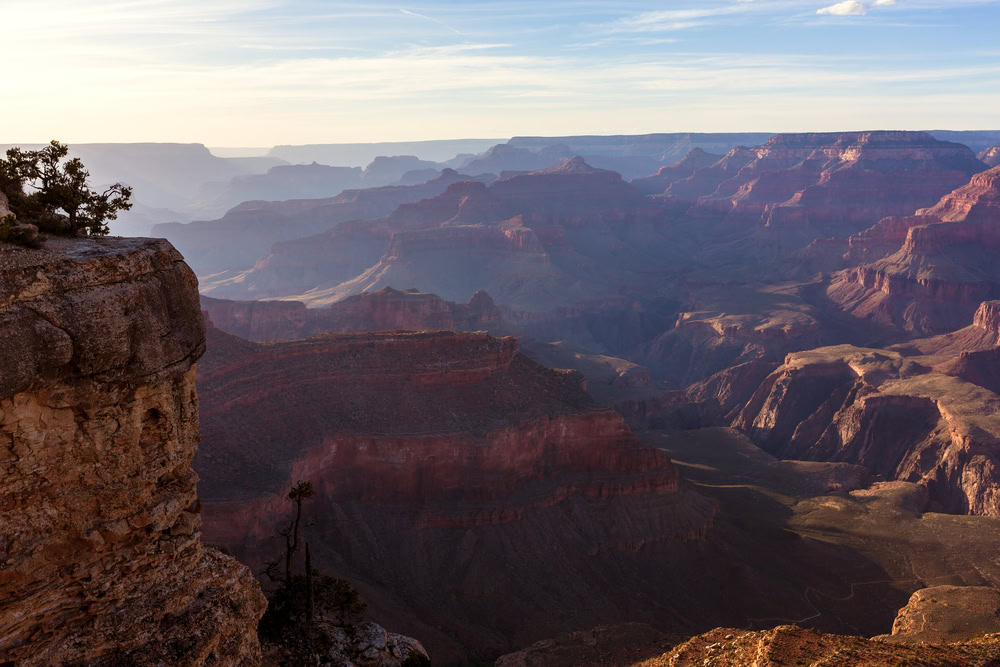
Beyond being an excellent viewing point, Mather Point is also the first stop along the famous Rim Trail, a must for any Grand Canyon road trip.
Promising views of the canyon will leave you breathless, with plenty of lookout points ensuring you won’t miss a thing. It’s a perfect way to experience all the South Rim offers.
Some of the most famous stops on the trail include:
- Yavapai Point
- Yaki Point
- Powell Viewpoint
- Hopi Viewpoint
- Mohave Viewpoint
- Hermit’s Rest
The trail is very well-maintained and straightforward, making it great for first-time visitors. It stretches for 13 miles and can take several hours to complete. And while that is a fantastic idea, with just two days in the canyon, I recommend only completing a portion of it.
The shuttle bus service runs along the trail, making hopping on one back to your starting point a breeze. Connecting multiple viewpoints, tourist amenities, and numerous hiking paths along the South Rim, the Rim Trail is a spectacular choice for epic sights.
No matter where you choose to stop and take in the scenery, you’re in for unrestricted views of the other side of the canyon. Making the trail even more worth it is that you can bring your dog along for the journey.
That being said, there are a few things to keep in mind when heading out on this trail. Even though it is very accessible, some sections take you close to the edge of sheer cliffs with no guardrails.
While the trail is open year-round, it gets boiling during the summer and extremely cold during the winter, so keep an eye on changing weather conditions. Last but not least, remember that off-trail hiking is not allowed, so stick to the designated path.
If you’re not keen on hiking the Rim Trail, you can opt to rent a bicycle from Bright Angel Bicycles at the visitors center. They do rentals from 8 am to 5 pm, and you can keep them for 24 hours, so overnight rentals are possible.
Check Out Yaki Point
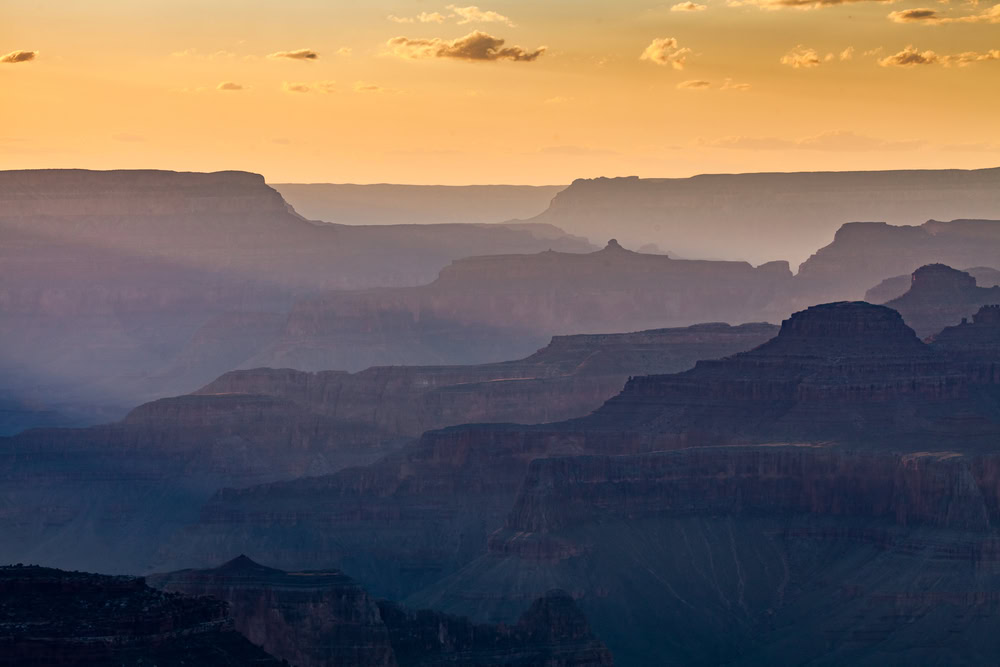
Deserving its spot in your first-day itinerary, Yaki Point is, without a doubt, one of the Grand Canyon’s South Rim standouts. Although many flock to Yavapai and Mather Points, Yaki Point is in a league of its own and is frequently less visited.
Taking the orange shuttle, you’ll reach the start of a short 20-minute walk to the actual viewing point. Luckily, the path leading you there is paved, and it’s a casual stroll to one of the most captivating lookout spots in the Grand Canyon.
Thanks to Yaki Point being located on a different peninsula, the surrounding scenery and accompanying canyon views are unique, giving you a chance to see another side of the natural wonder.
You can easily spot some of the area’s dominating features from the viewing platform, like the Zoroaster Temple on the other side of the Colorado River. Another prominent sight is Wotan’s Throne, a large flat-top butte rising from the canyon floor.
Towards the western side, you’ll have clear views of the final section of the Bright Angel Trail, a part of the Tonto Trail, and much of the South Kaibab Trail. Along the eastern side, you’ll gaze out onto Cremation Creek and the many buttes and mesas that collectively form Clear Creek on the North Rim.
See the Sunset at Ooh Aah Point
- Mileage: 1.8 miles out and back
- Elevation Gain: 685 feet
- Difficulty: Moderate
- Trail Guide: Link
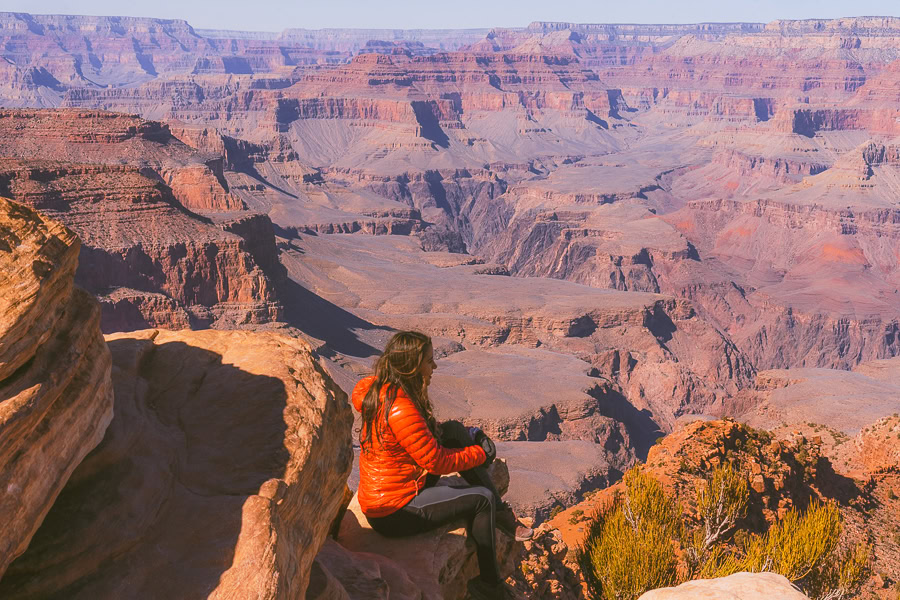
As the day comes to a close, it’s time to face a problematic Grand Canyon decision. Where do you choose to watch the sunset?
Now, there is no shortage of near-ethereal spots in the canyon, but Ooh Aah Point steals many hearts. The short 1.8-mile hike to the viewing point isn’t all that challenging, and a round trip should take roughly an hour to complete.
You’ll have to venture onto the South Kaibab Trailhead until you get to the Ooh Aah Point signpost to reach the trailhead.
As you make your way along the path, you’ll find mesmerizing views on all sides that really take this trail’s beauty to another level. At the culmination of the trail lies Ooh Aah Point, and as a reward for reaching it, an ocean of desert canyon panoramas awaits. Thanks to its position, you’ll be able to see as far as the less visited East Canyon and the West Canyon.
Descending below the rim of the Grand Canyon, this is one of the best short hikes in the park, and with its unique views from below the canyon, rim one of the most scenic. After dark, the viewpoint takes on another appeal and delivers some of the most exceptional stargazing opportunities you’ll ever find.
Even though the hike is straightforward, it does have a 685-foot descent along the canyon walls and can present challenges on the way back. With a little bit of fitness, it shouldn’t be a hassle, though.
With your first day in the Grand Canyon nearly finished, after taking in the beauty of Ooh Aah Point, you should stop by the El Tovar Hotel. A hotel? One of the best ways to close a day at the canyon is by indulging in the delicious food served at the El Tovar Dining Room.

Top Tip: You can continue along South Kaibab Trail and go beyond Ooh Aah Point if you like. Just note the next closest point of interest is at Skeleton Point, a further four miles.
Day Two in Grand Canyon National Park
After a thrilling first day and a good night’s rest, it’s time to kick off what will be another unbelievable day discovering the park’s vast natural beauty on this Grand Canyon 2-day itinerary.
Most of today will focus on the many fantastic viewpoints along Hermit’s Rest Road, with a few optional extras if you have time.
Tour Hermit’s Road Viewpoints
Around 7 miles west of Grand Canyon Village, Hermit Road might not be that long, but its short distance holds a staggering nine official viewpoints. How you go about seeing each is up to you, and you can choose to use the complimentary shuttle, head on a bike ride, walk the Rim Trail, or a combo of the three.

Note: If you’re driving, remember that private vehicles are only allowed between December and February.
Trailview Overlook
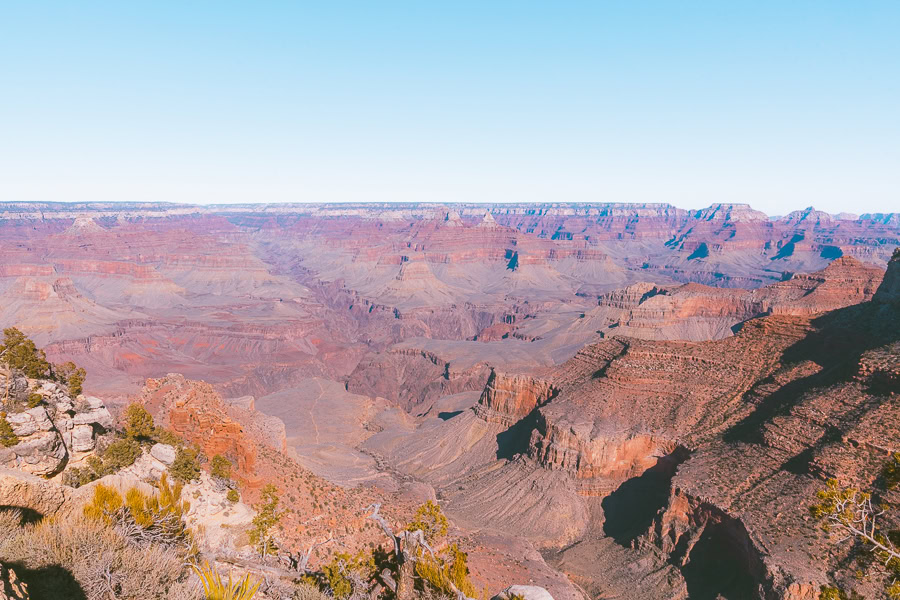
The first destination along Hermit Road is the Trailview Outlook, roughly 0.7 miles from the start of the road at the shuttle transfer station. The viewpoint gets its name from the stunning scenes it gives of the famous Bright Angel Trail.
From here, you can tackle Bright Angel trailhead just off the Village, with its many brutal switchbacks, and the 3,000-foot descent to Indian Garden (Havasupai Garden). Other notable sites include the Colorado River, Phantom Ranch, and the El Tovar Hotel.
As for the overlook itself, there are two main viewing platforms, each with guardrails and several accessible cliff-top overlooks.
Powell Point
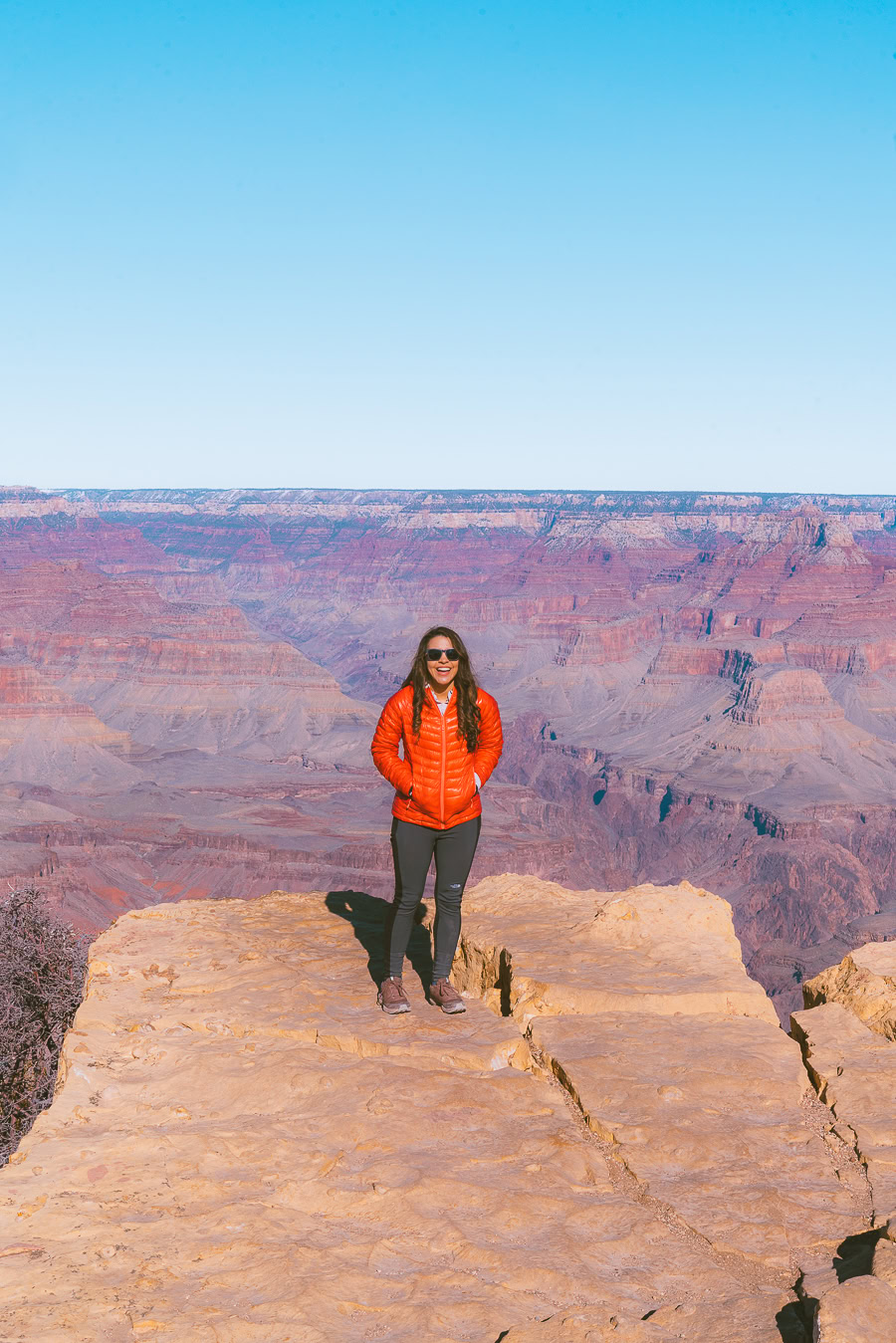
About one mile after Trailview, the next must-see spot on Hermits Road is Powell Point and the Powell Memorial, which stands at the overlook.
Here, you can feast on various expansive views, and you’ll also have the chance to admire the large memorial dedicated to the first exploratory trips down the Colorado by Major John Wesley Powell.
You’ll find a stone staircase at the overlook leading directly to the monument and panoramic canyon views.
Hopi Point
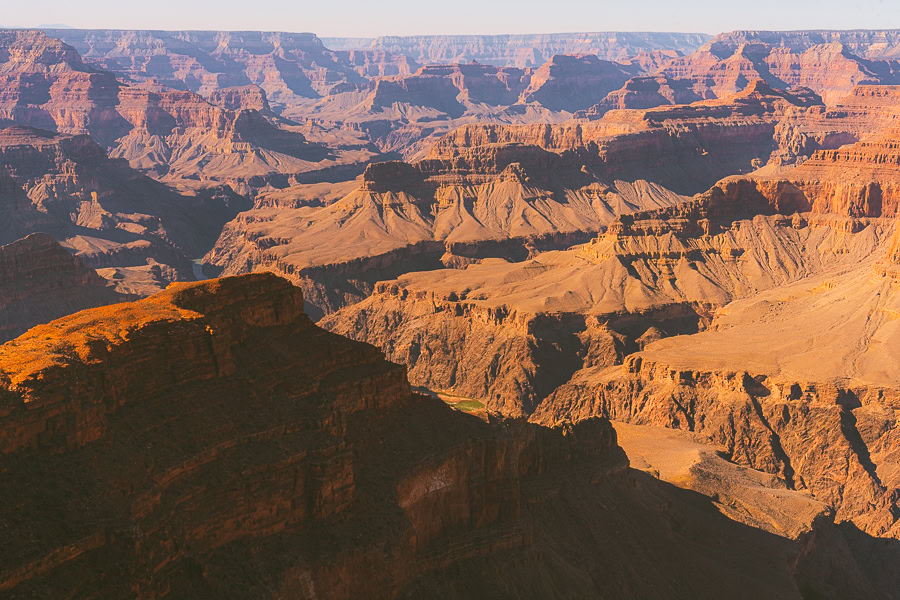
Next up is one of the most beloved Grand Canyon views for many, and it’s not hard to see why. You’ll reach Hopi Point about 0.3 miles after Powell Point, which means you won’t have to walk far for an absolutely captivating scene.
It’s at Hopi Point where you can quickly get a true sense of the dramatic and immense scale of the Grand Canyon, especially as you gaze at the sinking river below. With panoramic views to the east and west, it also makes for a mindblowing spot to catch either the sunset or sunrise.
At sunset, especially, it’s a fantastic spectacle to witness as the sun’s light retracts and the evening glow envelops the surrounding area. Keep an eye out for Shiva Temple and Zoroaster Temple for some epic snapshots.
Mohave Point
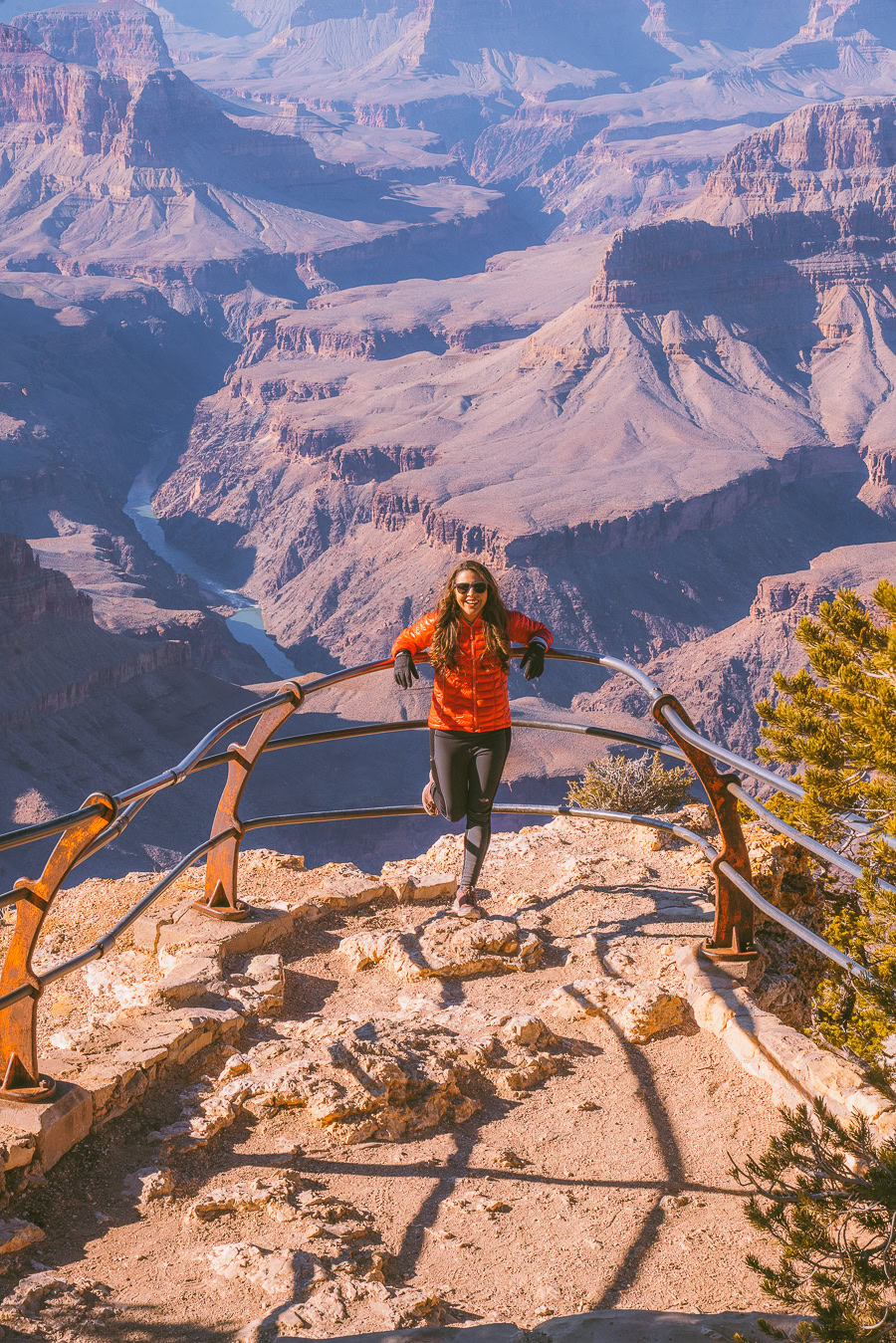
Sometimes, you just really want to add a little more vastness to a viewpoint, and that’s even more true when visiting the Grand Canyon. For a blissful overdose of vastness, look no further than Mohave Point.
Sitting about 0.8 miles from Hopi Point, this is another gorgeous spot to catch sunsets and sunrises, as there aren’t as many buttes blocking your view. Often called the “alligator”, the Mohave viewpoint delivers magnificent views of the Colorado River 5,000 feet below.
From the vantage point, you’ll see three distinct rapids: Salt Creek, Granite, and Hermit. Other stunning sights include unique formations such as the Tower of Set and the Tower of Ra.
The Abyss
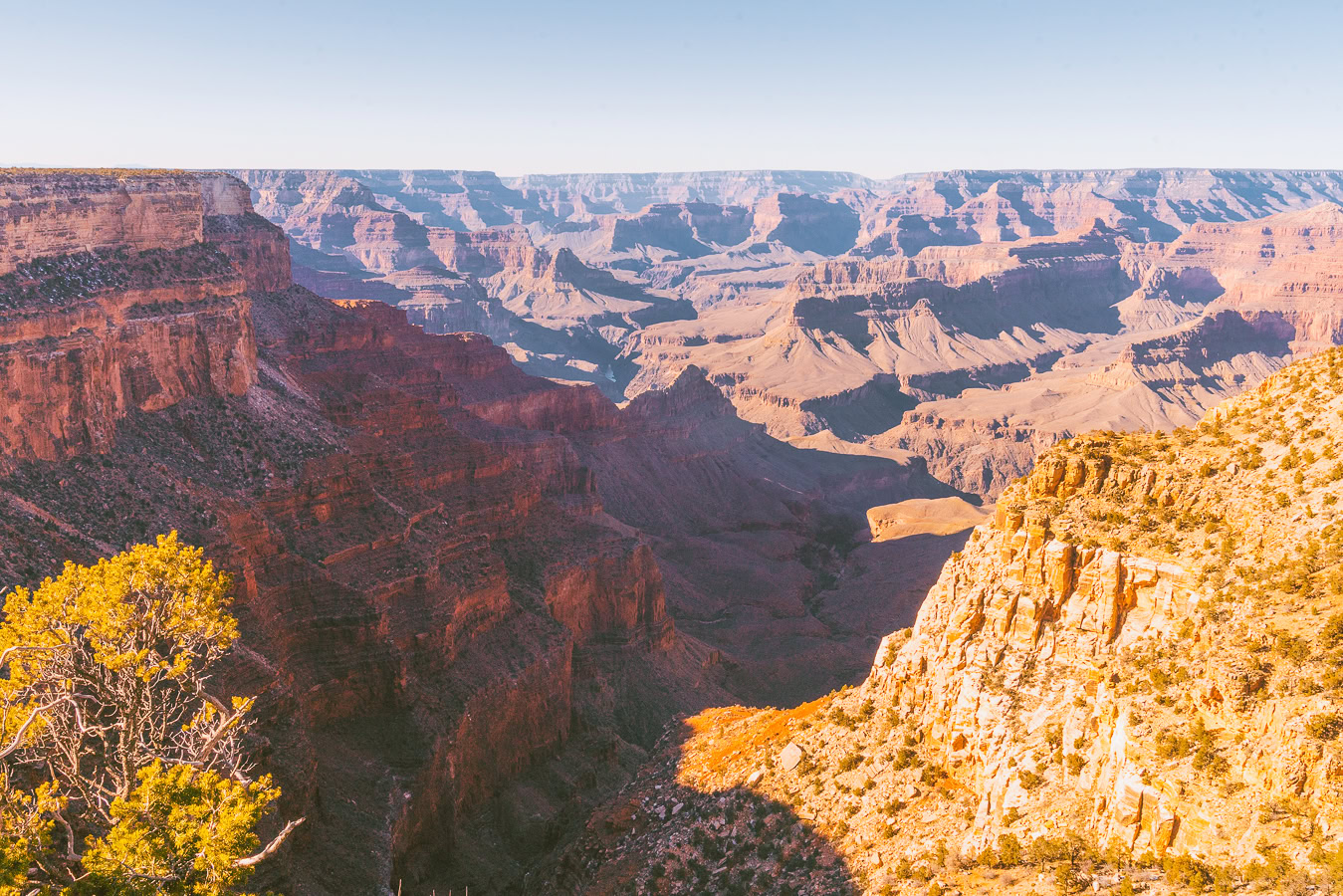
Next up, 1.1 miles from Mohave Point, lies The Abyss, which genuinely lives up to its name. There aren’t many overlooks that are as steep as this one, and from the top, you’ll face the longest vertical drop anywhere along the Grand Canyon South Rim.
As you stand at the viewing platform, you’ll stare down a 2,600-foot drop straight down over the sheer cliffs that descend into the canyon. These sheer cliffs are the result of gravity slowly eating away at the rockface over millions of years. On some days, you’ll even be able to spot campers at Monument Creek, which is far down below.
Monument Creek Vista
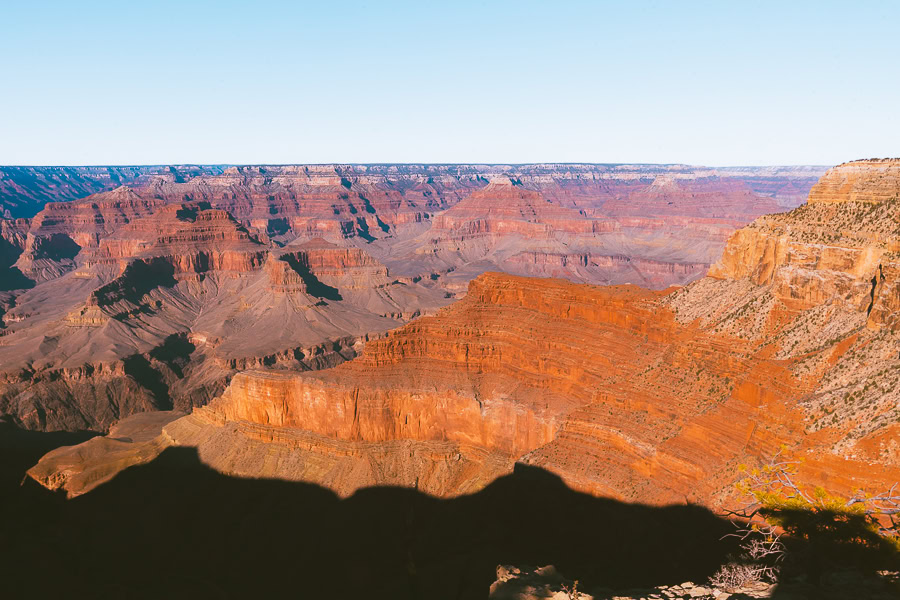
Speaking of Monument Creek, your next destination is Monument Creek Vista, 0.9 miles from The Abyss. Offering impressive views of the Granite Rapids on the Colorado River, this is also the starting point of the Greenway Trail.
A historic carriage road, the trail is a paved pedestrian path that heads west towards Hermits Rest. In total, six individual overlooks make up the Greenway Trail, with Monument Creek Vista being the first.
Pima Point
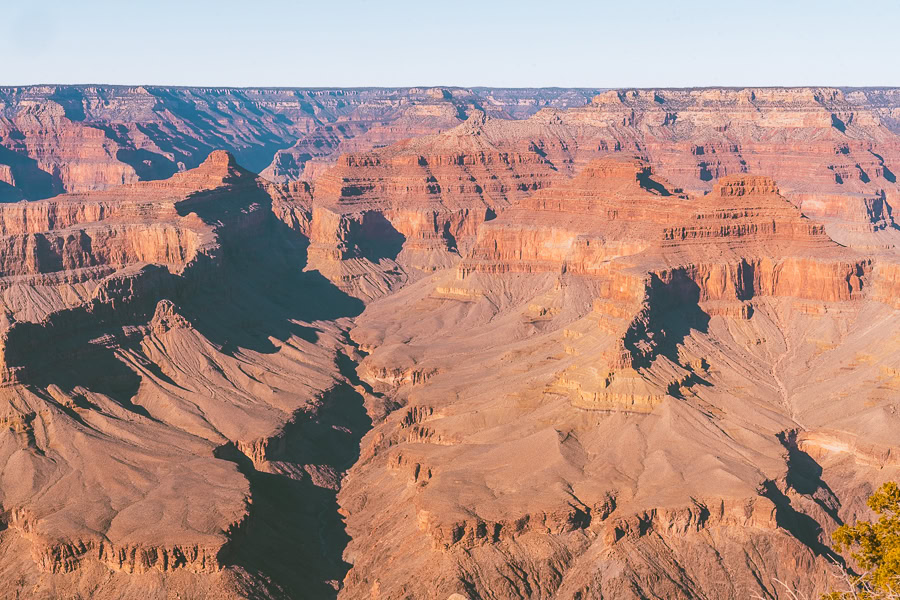
About 1.7 miles after Monument Creek Vista lies Pima Point. Presenting one of the top places to see and, at times, hear the mighty Colorado River as it snakes through the canyon.
If you’re visiting during a tranquil day, hearing the rapids echo up the canyon wall adds an extra element to the already fabulous views. As Pima Point is part of Greenway, it’s accessible to cyclists and wheelchairs.
Aside from the breathtaking views of Granite Rapids below, you’ll spot other highlights while gazing out further. Set within panoramic views, you can see past Mohave Point in the east, and to the west is the 7,000-foot high Cataract Plains plateau.
Hermit’s Rest
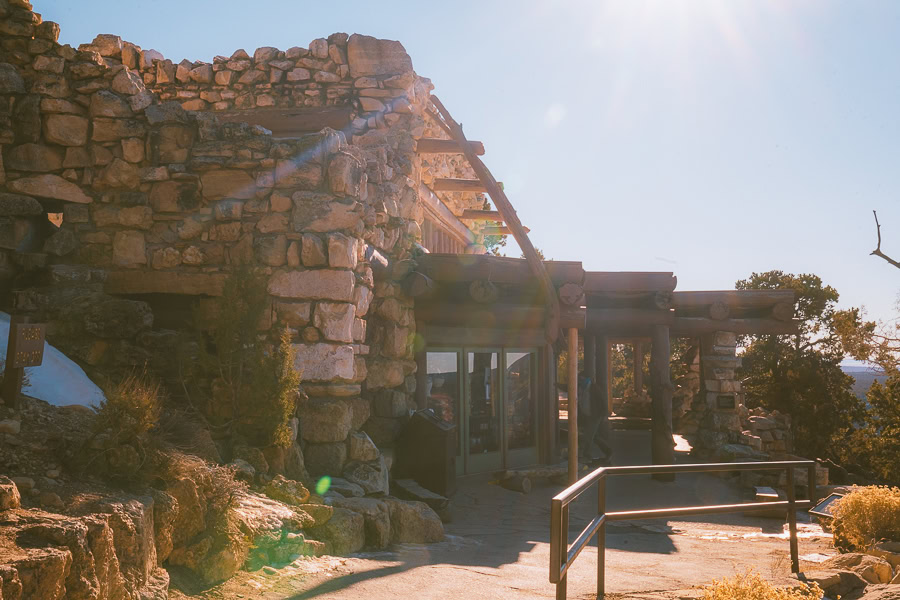
The final stop along Hermits Road, you’ll reach Hermit’s Rest after 1.1 miles. Named after the hermit of Hermit Creek Basin, Louis D Boucher, this overlook also signifies the western end of the Rim Trail.
Although a hermit, Louis wasn’t just any hermit. During his youth, he was a prospector who staked claim to much of the area today known as Hermits Rest, and he helped carve the Rim Trail while living alone for over 20 years.
Once here, you’ll be welcomed by spectacular views of the Grand Canyon rim, as well as the Hermits Rest building, designed by famous architect Mary Coulter. Envisioned to replicate an old miner’s cabin in 1914, a gift shop and snack bar are inside.
If You Have Time: Catch the Sunset at Desert View Watchtower
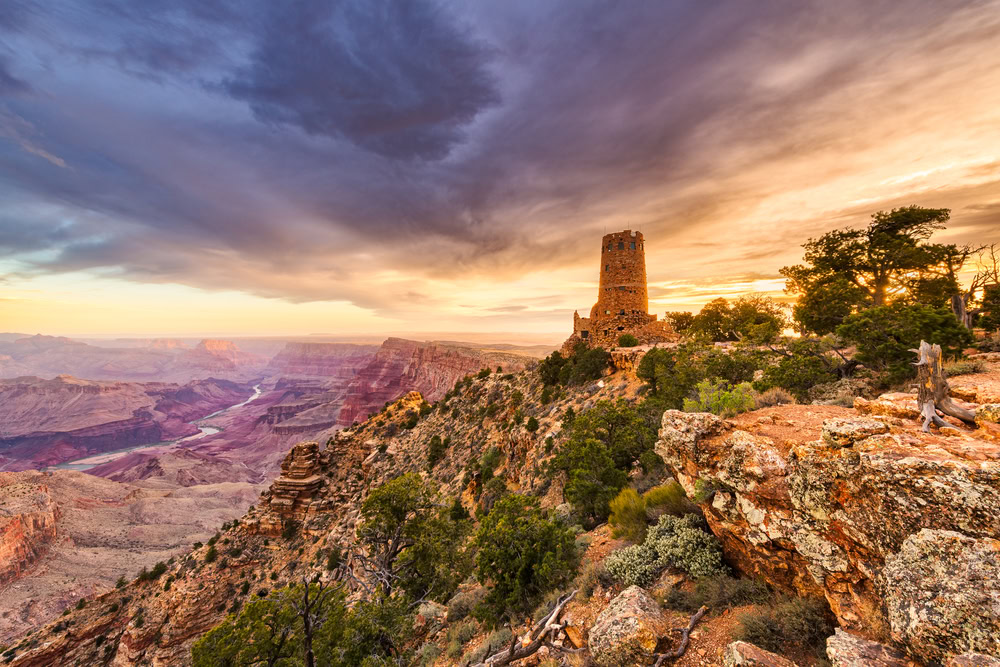
If you’ve budgeted your time well enough and have a few hours to spare before ending your second day at the Grand Canyon, there are a few options for additional attractions. One of the best is the Desert View Watchtower on the canyon’s east side.
Located 23 miles from Grand Canyon Village, Desert View is by far the most built-out area on this side of the canyon, and its crowning jewel is the 70-foot tower. Built in 1932, the observation deck allows you to see miles into the canyon, delivering mind blowing vistas.
Be sure to check out the lowest floor, the Kiva Room, where Native American cultural demonstrations occur on certain summer days.
Claim your FREE Hiking Checklist
Ready to start hiking? Grab my free hiking checklist and never forget anything at home!
Optional: Plateau Point via Bright Angel Trail
- Mileage: 12.2 miles out-and-back
- Elevation Gain: 3,195 feet
- Difficulty: Challenging
- Trail Guide: Link
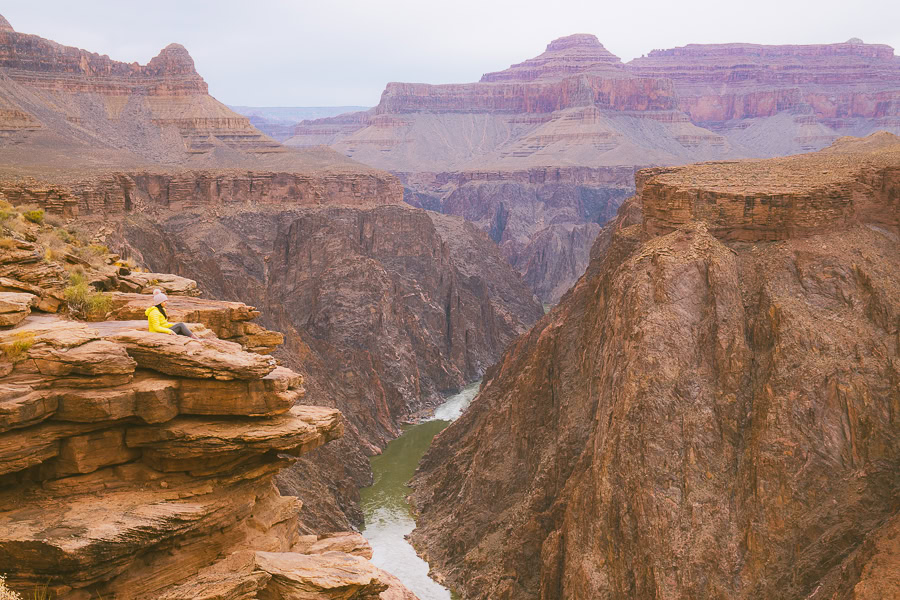
Let’s face it. Spending two days in the Grand Canyon is an out-of-this-world experience, and there’s simply so much to do. Now, you might be wondering about the famed Bright Angel Trail to Plateau Point, which is one of the most popular hiking trails in the park and is definitely worth your time.
That being said, this is an exceptionally difficult trek, and with its 3,195-foot descent and almost 100 switchbacks, it’s an experienced hiker’s dream. Leading to the Havasupai Gardens and, finally, Plateau Point, with most choosing to camp at the Gardens for a night.
On the trek, you’ll get captivating canyon views as you venture down the South Rim of the Grand Canyon with condors flying high above. From Havasupai Gardens, you can witness the Colorado River diving into the canyon’s depths.
Remember that you’ll need to have a backcountry permit from the Grand Canyon Backcountry Information Center to camp overnight. As a reward for completing the hike, stop by the Bright Angel Lodge for some fantastic ice cream.
Best Time To Visit the Grand Canyon
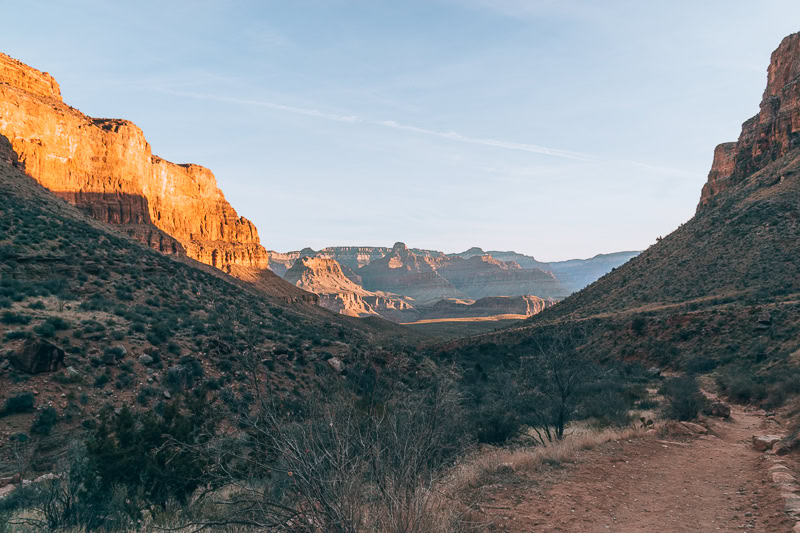
Deciding on when to visit the Grand Canyon can be somewhat difficult as the canyon’s weather can be unpredictable. Thanks to the altitude at which both the North Rim and South Rim sit, summers get very hot, and winters get icy cold.
This means that, in general, spring and fall are considered the best times to visit the Grand Canyon, with mild weather conditions and slightly smaller crowds. Below is a breakdown of what to expect during each season.
Grand Canyon National Park in Spring
Springtime, from March to May, brings with it pleasant weather and mild temperatures, but it can get freezing cold at night. With fewer crowds compared to the summer, you’ll have more of a laid back time, but remember that it is spring break, and as such, it is still a popular time for many to visit the park.
Grand Canyon National Park in the Fall
Similar to spring, during the fall, from September to November, mild temperatures and calm weather conditions dominate the park. That, and the fact that there’s no spring break, make the season a great time to plan your visit, as it’s typically when there are the least tourists visiting.
Grand Canyon National Park in Summer
The most popular time for people to visit the canyon is during summer, from June to August, but the season brings extremely hot weather and scorching temperatures. This can make hiking difficult, especially if you plan on going far below the rim of the canyon. Summer also sees afternoon showers almost daily as it’s the local monsoon season in Arizona.
Grand Canyon National Park in Winter
During winter, from December to February, crowds are at a low in the canyon. Thanks to the elevation of the rim, the temperatures dip very low, and you could encounter snow. Most trails below the rim turn icy, making hiking challenging, but you’ll be able to self-drive Hermit’s Rest Road, which is only possible from November to February.
Read More: Best Time to Visit Grand Canyon National Park
How To Get to the Grand Canyon
Depending on where you’re coming from, you can choose to enter the Grand Canyon from its south entrance, north entrance, or Desert View entrance. For this itinerary, though, it’s recommended that you head through the southern gate to the park.
Reaching the Grand Canyon’s southern entrance from Las Vegas requires a four-hour and fifteen-minute drive of 277 miles, starting at the Harry Reid International Airport (LAS). A straightforward drive will lead you to Grand Canyon Village and, from there, the entrance.
Alternatively, you can head through Phoenix, which will take about the same time as the drive from Las Vegas. You’ll get to see Sedona on the way as well.
Where To Stay When Visiting the Grand Canyon
Seeing as you’ll spend 2 days in the Grand Canyon, you’ll need to find just the right place to spend your one night in the canyon. Luckily, there are a few options you can choose from, and there’s something for every type of budget.
Budget | La Quinta by Wyndham Williams
If you’re traveling on a budget, then choosing to stay at the La Quinta by Wyndham is a fantastic idea. Located in Williams, this 3-star property has everything you could need for your trip, with features including an indoor swimming pool. >>>Check Availability.
Mid-range | Under Canvas Grand Canyon
For a genuinely memorable overnight stay, Under Canvas Grand Canyon is a great option, and while it’s more on the higher end of mid-range pricing, it’s well worth it. It’s camping done comfortably with organic bath products, morning yoga, and nightly s’mores under the majestic night sky. >>>Check Availability.
Luxury | The Grand Hotel at The Grand Canyon
You’re spending just one night at the canyon, so why not stay in the lap of luxury? Well, book a suite at The Grand Hotel located in Tusayan. Featuring exceptional design and styling, this 5-star property boasts an on-site restaurant, indoor pool, hot tub, and nightly entertainment. >>>Check Availability.
Read More: Where To Stay at the Grand Canyon | 22 Best Hotels, Cabins & Campgrounds
Tours Of Grand Canyon National Park
Got Three Days? Here’s How To Spend 3 Days at the Grand Canyon
If you’re lucky enough to have three days to spend exploring the Grand Canyon, then you’re probably wondering how to go about it. Below is a quick run-through of what to do with your time.
Day One of Three Days at the Grand Canyon
- Catch the sunrise at Mather Point.
- Explore the viewpoints of Hermits Road.
- Grab lunch at the Grand Canyon Village.
- Visit the Yavapai Museum.
- Sunset at Yaki Point.
Day Two of Three Days at the Grand Canyon
- Short morning hike below the rim.
- Go on a helicopter tour of the canyon.
- Do a scenic drive on Desert View Drive.
- Take a mule ride into the canyon.
Day Three of Three Days at the Grand Canyon
- Tackle one of the challenging day hikes below the rim. You can choose to do either the Bright Angel Trail, the Grandview Trail, the Hermit Trail, or the South Kaibab Trail. Alternatively, you can go on the Rim to Rim Trail.
What To Pack For Hiking The Grand Canyon
- Sunscreen: This is a no brainer. There are areas on the trail where there is no shade. Slather some on right before the trek. >Buy Sunscreen
- Hiking Boots/Shoes: If you use tennis shoes you can easily hurt your toes hitting a rock by accident (Trust me I have done it so many times before). >Check Out My Hiking Shoes
- Hiking socks: Having the correct socks helps you prevent getting blisters. Smart Wool is probably my favorite brand out there. I also love how they now have pink socks too 🙂 >Buy Hiking Socks
- Refillable water bottle: I always bring a Hydroflask on all my adventures. They are on the heavier side but I know for a fact they will not break. I have had a few cheap water bottles break on me before. There is no room for error at the Grand Canyon. >Check Prices Now
- Lots of water: The Grand Canyon is HOT. Bring a ton of water!
- Sunglasses: Like I said it can get pretty sunny.>Check Out These Sunglasses
- Snacks: The best snacks are jerky, nuts, energy bars. Cliff Bars are great for hiking.
- Trekking Poles: This is an optional product, but they really help with the knees. The poles I have listed are known to be one of the best in the market. >Buy The Trekking Poles Here
- Camera: I have linked the camera I used to take pictures of the Grand Canyon. The Sony A6000 is a great camera for people that want to start improving at travel photography. >Buy Sony Camera Here
- First Aid Kit: This is one of the first things I bought when I first started backpacking and camping. It is super portable. >Buy This Awesome First Aid Kit Here
- Day Pack: The REI bag I have linked, we have had for seven years now, and it is still going strong! >Buy This Great Quality Backpack
- Good hiking pants: These are probably the best hiking pants that I have found. They keep you dry in the crazy weather and they are durable. >Buy my hiking pants here
- Breathable sweat-wicking shirts: >Check This One Out
- Sports Bra: For women. >Buy One Here
- Jacket: Only in the winter >Buy My Favorite Jacket
- Base Layers: This is only needed in the winter. If you get chilly like me this is necessary! I have been using Smartwool for years now and they are my go-to base layers. >Buy the bottoms here, >Buy the top here
- National Park Pass: I highly recommend getting a year-long America The Beautiful Pass. >Get It Here
- Map: I love the National Geographic Maps! They are the best! >Buy One Here
Claim your FREE Hiking Checklist
Ready to start hiking? Grab my free hiking checklist and never forget anything at home!
FAQs About Visiting the Grand Canyon
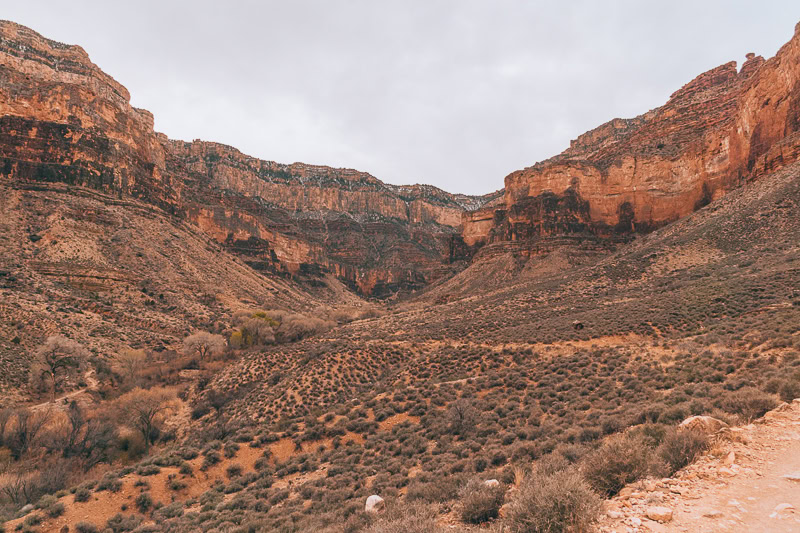
If you still have some burning questions about your 2-day itinerary for the Grand Canyon, you’re in luck. Below are some of the most popular questions many have.
How Much Time Do You Need At the Grand Canyon?
How many days to spend in the Grand Canyon ultimately depends on what you want to see. If you’re visiting only to see the South Rim, then the ideal time would be either two or three days. The North Rim, on the other hand, only really needs one or two days. Should you want to see both, then go for five days.
Which Is Better? Bright Angel Trail vs South Kaibab Trail
While this comes down to personal preference, for many, the best trail is Bright Angel, as it features more water stops and a less challenging overall hike. On the other hand, the South Kaibab Trail does have fewer crowds but features sections that even the most experienced hiker could struggle with.
Can You Do the Grand Canyon and Zion National Park in One Trip?
Yes, you definitely can go to both the Grand Canyon and Zion National Park in one trip. You should plan to spend two days in each, giving yourself enough time to explore both.
Go Explore the Grand Canyon | Wrapped Up
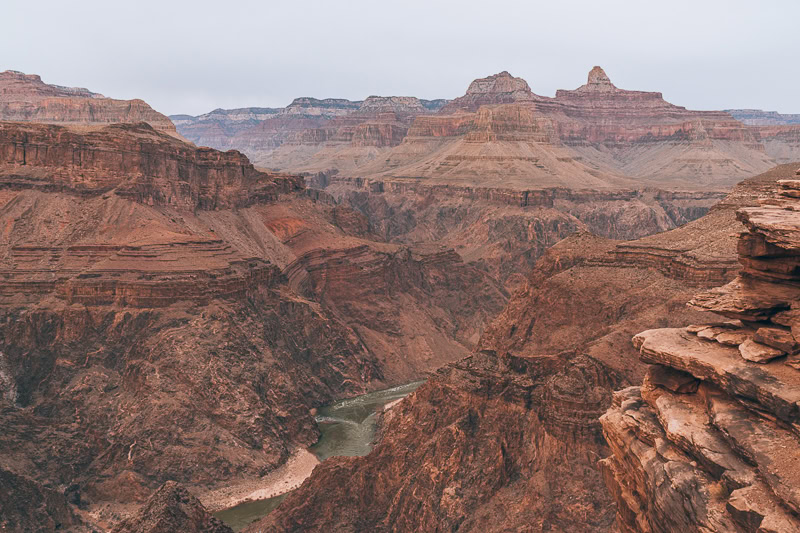
And that’s it, folks. A whirlwind two-day adventure to the Grand Canyon all wrapped up. Whether you’re eager for some incredible views or itching to tackle unbelievable hiking trails, there’s an endless amount of experiences awaiting you.
All that’s left to do is book your accommodation, get packed, and prepare yourself for the journey of a lifetime.
Read next: Where to stay at the Grand Canyon.

